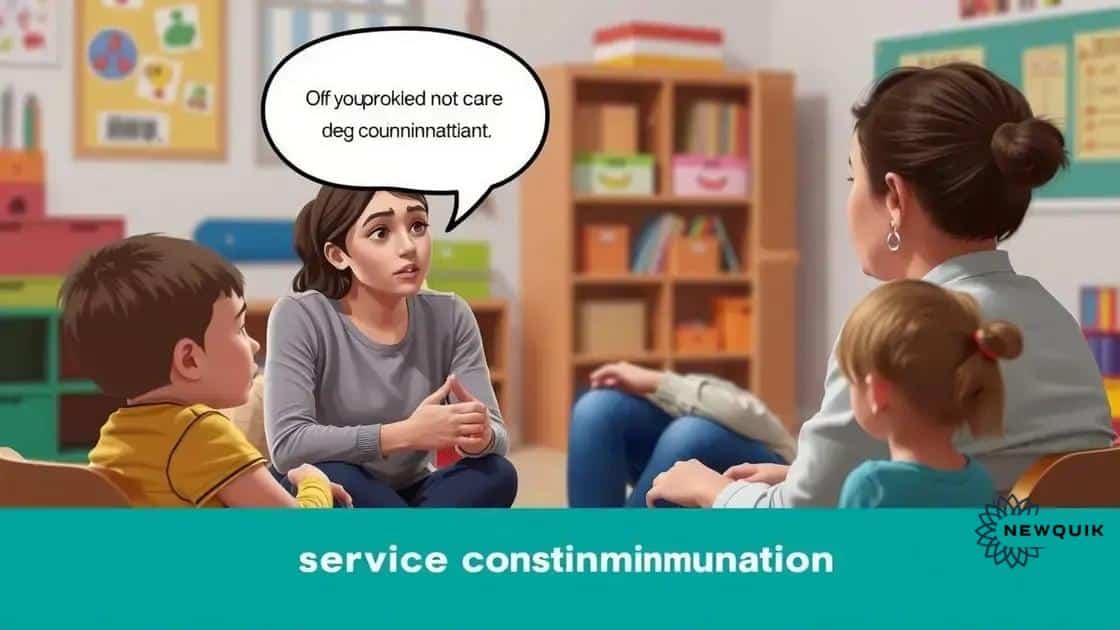Proposal to discontinue the federal Head Start initiative

The proposal to discontinue the federal Head Start initiative threatens access to essential early childhood education and support services for low-income families, impacting children’s development and future educational success.
Proposal to discontinue the federal Head Start initiative has sparked a significant debate about the future of early childhood education. Have you ever wondered what this means for millions of families relying on these crucial services?
Understanding the Head Start initiative
The Head Start initiative is a program designed to support young children and their families by providing comprehensive early childhood education. It launched in the 1960s with the aim of promoting school readiness for children from low-income families. Today, this initiative continues to play a vital role in many communities.
Understanding the significance of the Head Start initiative requires looking at its goals and benefits. The program focuses on several key areas:
Key Focus Areas of Head Start
- Education: Quality early learning experiences help prepare children for school.
- Health: Access to health services ensures children’s physical well-being.
- Family Support: Resources are available for families to foster a stable home environment.
- Community Engagement: The program connects families with local resources and networks.
These components work together to provide children with a solid foundation for future learning. Many families rely on the Head Start initiative not only for educational support but also for addressing social and economic challenges. For instance, involvement in the program can lead to improved academic performance and greater self-confidence in children.
The success stories from families who have participated in the Head Start initiative illustrate its impact. Children gain foundational skills, while parents often find support in parenting education and job training. This comprehensive approach addresses multiple aspects of a child’s development, presenting a holistic model for early childhood education.
Historical context of Head Start
The Head Start initiative has its roots in the early 1960s, a period marked by social change and a growing awareness of the need for early childhood education. The program was created as part of President Lyndon B. Johnson’s War on Poverty, aiming to improve educational opportunities for children from disadvantaged backgrounds.
Initially, Head Start focused on helping children develop skills necessary for kindergarten readiness. It recognized that many low-income families faced barriers that affected their children’s learning and growth. Over time, the initiative has evolved to encompass a holistic approach to childhood development, addressing health, nutrition, and parental engagement.
Key Milestones in Head Start History
- 1965: Launch of the Head Start program as a summer pilot.
- 1975: Expansion of services to include children with disabilities.
- 1994: Introduction of the Early Head Start program for infants and toddlers.
- 2007: Emphasis on school readiness and comprehensive services gets reinforced.
Throughout its history, the Head Start initiative has been influential in shaping policies related to early childhood education. It highlighted the importance of investing in young children to break the cycle of poverty. Many studies have demonstrated its effectiveness, showing improved outcomes in academic achievement and social skills for children who participate.
The ongoing challenges of poverty, inequality, and access to quality education continue to shape discussions about the future of the Head Start initiative. Advocates argue for sustained funding and support to ensure that this vital program can adapt to the needs of future generations.
Impact of discontinuation on children and families

The potential impact of discontinuation of the Head Start initiative raises significant concerns for children and families relying on its support. Losing access to these vital services could set back progress for many children who benefit from early education and comprehensive care.
Without the Head Start program, many children may lack the educational foundation needed for success in school. Studies indicate that participation in such programs leads to improved literacy and math skills. The discontinuation could result in:
Potential Consequences
- Increased educational disparities between low-income children and their peers.
- Reduced access to health and nutrition services.
- Challenges for parents looking for child care and support resources.
- Negative effects on children’s social and emotional development.
Moreover, the effects extend beyond the classroom. Families often rely on Head Start not only for education but also for community connections and support services. The loss of this program may mean that parents face more difficulties in finding quality child care or accessing necessary health services for their children.
The impact on families could also lead to increased stress and financial burdens, as parents may need to seek alternative, often more expensive, options for child care and education. Consequently, children’s overall well-being could suffer, affecting their growth and future prospects.
Communities that lose Head Start services may notice a decline in school readiness among young children. This can create long-term challenges for education systems as they strive to address the needs of these children without the foundational support provided by Head Start programs.
Alternative programs and solutions
As discussions around the discontinuation of the Head Start initiative continue, many are exploring alternative programs and solutions to fill the gaps. These alternatives aim to provide children with the early education and support they need to succeed.
Numerous programs exist that complement or offer similar services to Head Start. Understanding these options can help families make informed decisions about their children’s education. Some alternatives include:
Key Alternative Programs
- Early Head Start: This program serves infants and toddlers and supports pregnant women, ensuring that families receive necessary assistance early on.
- Pre-K Programs: Many states offer publicly funded pre-kindergarten programs designed to prepare children for kindergarten.
- State Funded Child Care Programs: These programs provide financial assistance for child care, allowing parents to access quality educational environments for their children.
- Community-Based Organizations: Nonprofits often provide early education and family support services tailored to local community needs.
While these alternatives can help, it is important to assess what each program covers. Many options focus on education, while others include health services, parental involvement, and family support. Offering holistic services ensures that families have balanced resources.
The effectiveness of alternative programs varies, and not all communities have equal access. Families should look for programs that not only meet educational needs but also consider overall well-being. Engaging with local organizations can provide valuable insights into options available in specific areas.
Furthermore, advocacy for maintaining and enhancing funding for early education is essential. By identifying gaps and supporting new solutions, communities can ensure that children receive the quality education and care they deserve.
Community responses and advocacy
Community responses and advocacy play a crucial role in supporting the Head Start initiative. Local organizations, parents, and educators often come together to voice their concerns and highlight the importance of early childhood education. These collective efforts can significantly influence policy decisions and funding allocations.
Grassroots movements across the country have emerged to advocate for the preservation of programs like Head Start. Through petitions, rallies, and awareness campaigns, communities strive to make their voices heard. Here are some key aspects of community responses:
Importance of Community Engagement
- Raising Awareness: Communities work to inform the public about the benefits of Head Start, emphasizing its impact on child development and educational outcomes.
- Mobilizing Support: Local meetings and events help to gather support from parents and residents who believe in the value of these programs.
- Collaboration with Schools: Partnerships between Head Start programs and local schools enhance educational continuity for children.
- Engaging Policymakers: Communities reach out to local and state officials to advocate for funding and policy changes that benefit early education.
The involvement of parents is particularly vital. They often share personal stories that illustrate how Head Start has positively impacted their children’s lives. These testimonials can be powerful tools for advocacy, showing the need for continued support.
Furthermore, community organizations often provide resources to help families navigate the education system. They offer workshops, informational sessions, and access to support services. In this way, the community acts as a safety net, ensuring that families have the knowledge and resources needed to advocate for their children.
Ultimately, the strength of community responses and advocacy can shape the future of the Head Start initiative and other early education programs. By working together, communities can help ensure that children have access to the vital early learning experiences they need to thrive.
FAQ – Frequently Asked Questions about Head Start and Early Childhood Education
What is the Head Start initiative?
The Head Start initiative is a program designed to promote early childhood education for low-income children, offering comprehensive services including health and nutrition.
How would the discontinuation of Head Start affect children and families?
Discontinuation could lead to reduced access to educational resources, resulting in negative impacts on children’s academic readiness and overall well-being.
What are alternative programs to Head Start?
Alternative programs include Early Head Start, state-funded pre-K programs, and community-based organizations that offer similar educational and support services.
How can communities advocate for early childhood education?
Communities can advocate by mobilizing support, raising awareness, collaborating with local schools, and actively engaging with policymakers to emphasize the importance of funding.





